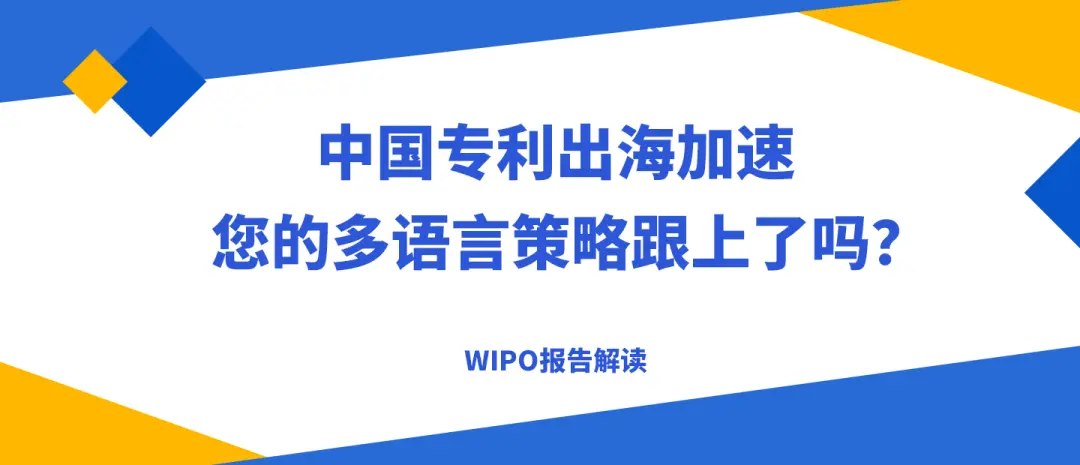WIPO Report Analysis: China's Patent Globalization Accelerates – Is Your Multilingual Strategy Keeping Up?
Is your company riding the wave of Chinese innovation to actively expand into global markets? As "going global" shifts from an option to a necessity, intellectual property—especially patents—becomes the cornerstone of a sustainable global strategy. The World Intellectual Property Organization’s (WIPO) World Intellectual Property Indicators 2024 report paints a vivid picture of global innovation trends, with China’s standout performance in the patent landscape, particularly its robust growth in overseas patent filings, signaling a clear trend: Chinese companies are rapidly integrating into the global innovation ecosystem. But amidst this surge, is language becoming an invisible barrier to your global ambitions?
The Rise of Chinese Patent Power and Accelerating Global Expansion
WIPO’s report highlights the resilience of global innovation despite economic challenges. In 2023, global patent applications reached a record 3.55 million, marking the fourth consecutive year of growth. China, once again, led the charge. The China National Intellectual Property Administration (CNIPA) processed 1.68 million patent applications in 2023, a 3.6% increase year-over-year, accounting for 47.2% of the global total. Since 2015, CNIPA has consistently handled over a million applications annually, underscoring the vibrant innovation ecosystem in China.
Even more striking is the pace of Chinese applicants’ global outreach. While domestic filings remain substantial, overseas patent applications (Abroad Filing) are growing at a remarkable rate. WIPO data shows that from 2013 to 2023, Chinese applicants’ overseas patent filings surged by 4.2 times. In 2023 alone, Chinese applicants filed approximately 120,000 patents abroad, trailing the U.S. (around 242,000) but demonstrating unmatched growth momentum and potential.
These figures send a clear message: Chinese companies are no longer content with dominating the domestic market. They are increasingly eyeing global markets, leveraging patents as a competitive tool on the international stage.
Target Markets in Focus: U.S., Japan, Korea, Europe Remain Key, with India Rising
Chinese companies’ overseas patent strategies are far from random. WIPO’s data reveals that the United States, Japan, South Korea, and the European Patent Office (EPO) remain the primary destinations for Chinese applicants.
- United States (USPTO): As the world’s largest economy and a hub for technological innovation, the U.S. is a top priority for Chinese patent filings. WIPO data indicates that in 2023, the USPTO received a significant share of non-resident applications from China, second only to Japan. Securing patents in the U.S. is critical for Chinese companies aiming to penetrate North America and compete in high-tech sectors.
- Japan (JPO) and South Korea (KIPO): As close neighbors and key technological competitors, Japan and South Korea are vital markets. Chinese patent filings in these countries rank among the highest, driven by intense technological competition in fields like electronics, automotive, and semiconductors.
- Europe (EPO): The EPO offers a streamlined pathway to multiple European markets. Chinese applicants have steadily increased their filings at the EPO, making China one of the top source countries in 2023. For companies targeting Europe’s vast market, EPO patents are a strategic choice.
The report also highlights India as an emerging hotspot. In 2023, India saw a 15.7% increase in patent applications, marking five consecutive years of double-digit growth. Notably, domestic applications surpassed non-resident filings for the first time, accounting for 55.2% of the total. This signals India’s growing innovation capacity and market potential, making it a strategic focus for Chinese companies eyeing emerging markets.
Language Barriers: The Hidden Challenge of Patent Globalization
As Chinese innovations go global, language emerges as a critical bridge to cross. Patent documents, with their technical and legal complexity, demand translations of the highest quality, as they directly impact:
- Patent Grant Prospects: Inaccurate or ambiguous translations can lead to misunderstandings by examiners, increasing office actions, extending review timelines, or even resulting in rejections.
- Scope of Protection: The heart of a patent lies in its claims. Translation precision determines the scope of protection. Even minor errors can shrink the protected scope, leaving room for competitors to exploit.
- Stability and Enforcement: In licensing, transfers, or potential litigation, high-quality translations ensure the stability of patent rights. Errors or ambiguities can weaken a patent’s enforceability, undermining a company’s legal and commercial interests.
- Efficiency and Costs: Subpar translations often require repeated revisions, inflating time and communication costs and risking missed deadlines.
In key markets like the U.S., Europe, Japan, South Korea, and emerging markets like India, each jurisdiction has unique linguistic, terminological, and legal requirements. Literal translations fall short; high-quality patent translation demands a blend of technical expertise, legal precision, and cultural adaptation.
Giltbridge: Breaking Language Barriers, Empowering Global Innovation
As Chinese patents accelerate onto the global stage amidst a complex international landscape, choosing a professional and reliable language service partner is critical. Giltbridge, with nearly three decades of expertise in language services, has made intellectual property services—particularly patent translation—a core strength.
- Specialization and Expertise: Our team of over 100 full-time translators includes experts fluent in target languages and equipped with technical backgrounds (e.g., electronics, telecommunications, pharmaceuticals, chemicals, machinery) and extensive patent translation experience.
- Quality-Driven: Our rigorous quality management system—from translator selection to terminology management, translation memory, and multi-stage reviews—ensures every translation meets the highest standards of technical accuracy, legal precision, and linguistic fluency.
- Global Vision, Local Insight: As a Chinese language service provider, we deeply understand the needs and challenges of Chinese companies going global. We offer translation services from Chinese to key market languages (English, Japanese, Korean, German, French, etc.) and cater to emerging markets like India, enabling true global reach.
- Proven Experience: Nearly 30 years of industry expertise allows us to handle complex technical patent translations and tailor solutions to the specific requirements of different jurisdictions.
WIPO’s report makes it clear: China’s global innovation journey is accelerating. On this path filled with opportunities and challenges, language should not be a barrier. Giltbridge is committed to leveraging our expertise and experience in patent translation to eliminate linguistic obstacles, ensuring your innovations are protected effectively and promptly worldwide, and helping your company gain a competitive edge globally.
About Giltbridge
With nearly three decades of growth, Giltbridge has remained dedicated to pursuing excellence—constantly refining our service quality and technical expertise to deliver outstanding language, content, and intellectual property solutions. We’re excited to partner with you on your journey to international success, unlocking opportunities and driving innovation along the way.
Contact Center
Whether you need our services or just want to learn more, reach out to our team via email, phone, or social media. We’re eager to work together and explore the boundless possibilities of the global market with you.






